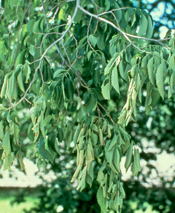 |
What is DED
What is DED
Dutch elm disease is a fungal disease that blocks water movement in infected elm trees leading to the death of the tree.
The American elm is most susceptible to Dutch elm disease. The introduced Siberian elm (sometimes incorrectly referred to as Chinese elm) is resistant to Dutch elm disease but sometimes becomes infected.
Infected trees may produce small sparse leaves in spring if infected late in the previous growing season. If infected during the same growing season, you may notice a sudden wilting of leaves, usually at the top of the tree, in early to mid-summer. Leaves curl and turn brown but may not fall from the tree. If infected in mid- to late summer, leaves may become yellow and fall prematurely. Symptoms can spread quickly throughout the tree. Infected branches often show a brown stain on the wood that can be seen by peeling back the bark.
 |
 |